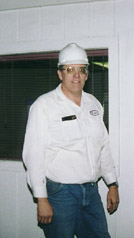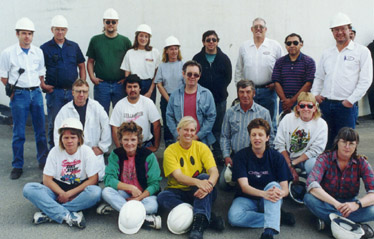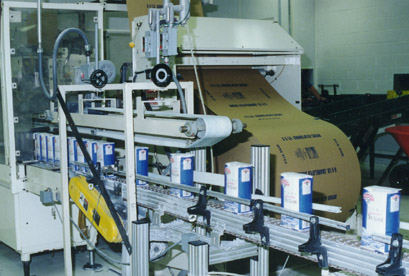By Lois Kerr
|
 Richard Metcalf |
 Warehouse Department Sitting (L to R): DeeAnn Sifuentes, Elaine Rang, Cindy Singer, Lisa Ziler, Karen Moerman. Kneeling: Ken Mocko, Martin Perez, Kelly Benzinger, John Beeler, Wendy Tasker. Standing (L to R): Allan Partin, Aubrey Miller, John Christenson, Michelle Farrow, Kathy Everett, Adam Herbst, Rich Metcalf, Juan Perez, Hank Berry. Not pictured: Robert Chatterton, Bonnie Damm, Kevin Damm, Marvin Damm, Alan Desjarlais, Robert Ernster, Doug Fink, Gene Fink, John Knoop, Randy Larson, Sandra Perez, Casimiro Perez, Denise Rossol andTerry Simonsen. |
Richard Metcalf, warehouse manager, advises that the Sidney plant packages sugar in 4, 5, 10, 25, 50, and 100 pound bags. As well, crews package flex totes, bags of sugar weighing between 2,000 and 2,500 pounds. The Sidney plant also ships bulk sugar. Forty percent of the sugar shipped from the factory leaves in bulk rail cars, which carry 190,000 pounds of sugar per car.
Sidney sugar, hauled by rail and by truck, goes to markets all across the country. The consumer packages, those in the 4, 5, 10, and 25-pound bags, go to warehouses on the East Coast and into the Chicago market area. The industrial sizes, or the 50 and 100 pound bags, go mainly to markets in the Midwest. Some of these industrial weight bags also go south and to the east. Flex tote sizes go mainly to the Chicago area and the East Coast. "Flex totes are usually ordered by companies who have formulated a recipe which uses one flex tote per batch," Metcalf explains. "The recipe is formulated to meet equipment capabilities, and with companies all over the country becoming more automated, the flex tote sales are expanding."
The rail cars of bulk sugar go virtually everywhere. Large manufacturers, such as Nestles and Kellogg's, buy and use sugar in bulk.
The nearly 50 warehouse employees at the Sidney plant work year round. Warehouse crews see peaks and valleys in sugar sales through the year, but thanks to the new silo system installed in 1995, the sales flow has evened out. "We wind up with full silos at the end of campaign," Metcalf says. "By the time we start up again, we are usually down to between 20,000,000 and 40,000,000 pounds of sugar, or 200,000 to 400,000 cwt."
Prior to the building of the silo storage system, warehouse crews generally loaded 12 to 14 rail cars per day. "There wasn't much available storage space," Metcalf says. "Crews had to load rail cars and move the sugar as the factory produced it."
Today, warehouse workers generally load three or four rail cars a day. The use of trucks for shipping also has increased in the last ten years. "Ten years ago, we maybe shipped two or three truckloads a week, Today, we load anywhere from 5 to 17 trucks per day," Metcalf remarks.
Metcalf explains that the Sidney factory acts as an emergency facility to help other Holly factories when they can't meet sugar demand. "We like to always have some sugar on hand," Metcalf comments. "We try never to completely empty our silos, because we are then able to react to emergency sugar requirements."
Metcalf expects the factory to produce 300,000,000 pounds of sugar this year, a record for the Sidney factory. "We used to have a good year when we produced 200,000,000 pounds," he says, "but we've been increasing production nearly every year now for the last ten years."
Seventy-five years ago, the Sidney plant packaged all its sugar in 100-pound cotton bags, which warehouse crews sewed shut. Sugar was hauled almost exclusively by rail, and workers stacked the 100-pound bags by hand. Most grocery stores also bought the 100-pound bags. Individual customers brought their own containers with them to the store and scooped from the opened 100-pound bags the amount of sugar they wished to buy. "They didn't have the technology to handle things they way we do now," Metcalf says. "Because of the lack of even the simple technology, such as fork lifts, everything was done by hard work."
Life got easier with new inventions and new technology. With the arrival of the computer age, computerized equipment has made the entire sugar extraction process, from extraction to shipping, more precise, sanitary and safe.
"I've seen more changes in the warehouse over the last 10 years than this factory has seen in the previous 65," Metcalf states. "With the new silo system, computers, automation and the ability of computers to control the entire process, we've taken a great leap ahead."
"The basic process of sugar extraction hasn't changed in 100 years," he adds. "What has changed, however, is the continual refinement of the methodology, giving us more and more control over the process."
When Metcalf began his duties as warehouse manager in
1989, the warehouse department had virtually none of today's technology.
"We  basically had a couple of calculators and a
four drawer filing cabinet," Metcalf recalls. "Today, we've got computers
with multiple programs and an external process computer."
basically had a couple of calculators and a
four drawer filing cabinet," Metcalf recalls. "Today, we've got computers
with multiple programs and an external process computer."
The warehouse runs three shifts, working a 24-hour day, 5 days a week. Crews do maintenance work on the weekends.